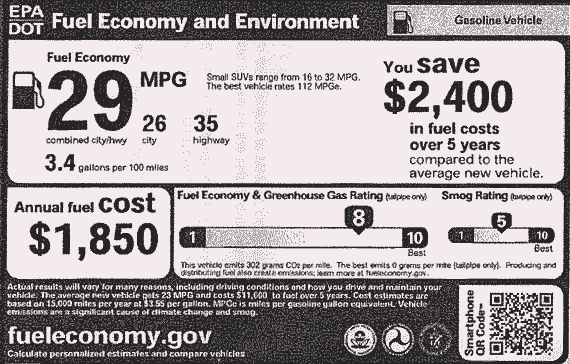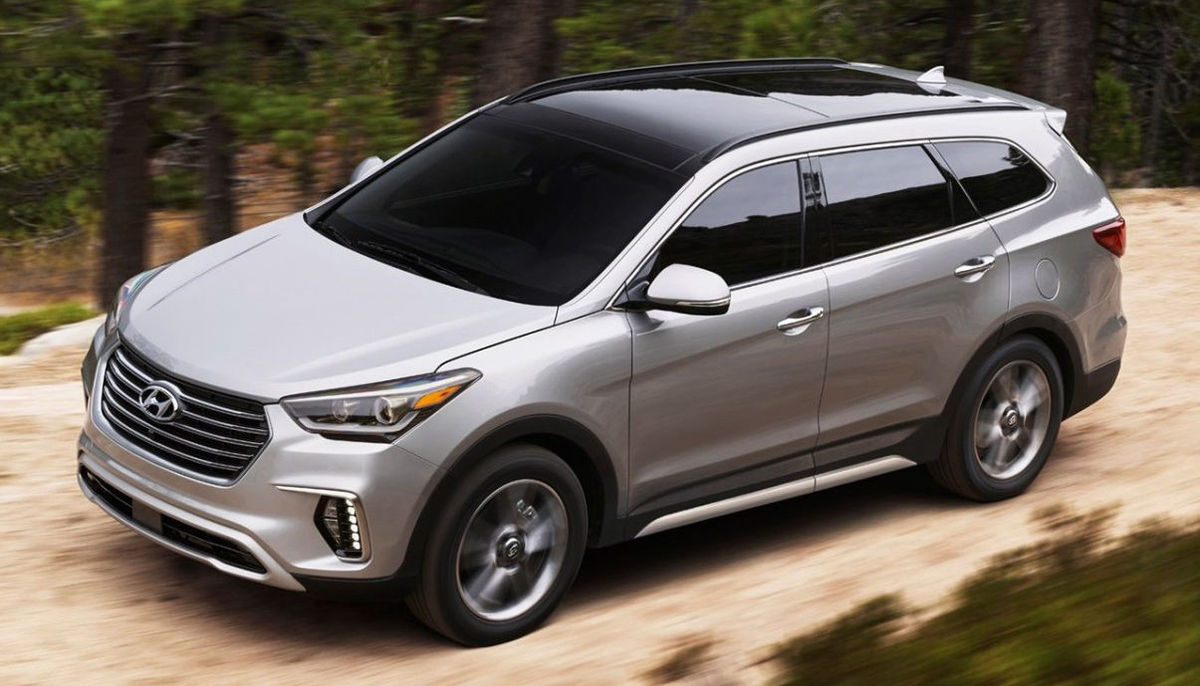The window sticker says 25 city, 34 highway – but you find that you’re seeing much less than that.
Is it false advertising?
Arguably, yes.
Minimally, it’s a case of not-so-good explaining.
I’ll try to fix that.
There is the advertised fuel economy – and then there is real world fuel economy.
The mileage touted on the window sticker is based on the mileage achieved during a test loop performed by the government (EPA), broken down in two categories – “city” and “highway” driving.
The problem with this is that it’s inherently imprecise. Every driver drives differently (e.g., accelerates more or less aggressively, drives faster – or slower, etc.). And of course, the roads you drive on – and the conditions you drive in (e.g., altitude, temperature) are inevitably going to be different than the test loop’s, too.
Hence the weasel words, “your mileage may vary.”
As an automotive journalist who test drives a new car each week, I have experienced some pretty spectacular differences between advertised and real-world fuel economy.
Of course, driving 130 MPH will do that.
But what about what you do?
Here are some factors affecting mileage – and why your real-world mileage will likely vary, too:
* City vs. highway driving –
A gas-engined car is least-efficient (gets the poorest mileage) in low-speed, stop-and-go “city” driving. It takes a lot of energy (fuel) to get a vehicle moving from a dead stop – even if you accelerate gently. It takes a fair amount of downward pressure on the pedal to get the car to get going; watch the tachometer, too. You will see the engine revs climb to 3,000 or more RPM (typically) as the car tries to build speed.
Think about how hard it to get a wheelbarrow full of bricks moving. Same principle.
This is why the “city” mileage figure is always lowest.
If most of your driving falls into this category, your average mileage – the figure that ultimately matters most – is going to trend closer to the city number, too. The lower number always drags down the higher one.
Once moving, on the other hand, it does not take nearly as much energy (fuel) to maintain speed. Think about that wheelbarrow again. Once you get it rolling, it’s not as hard to keep it rolling. High school physics… remember?
Believe it or not, it only takes about as much horsepower as produced by a riding lawn mower to keep a typical family car trundling along at 45 MPH. It hardly takes any pressure on the accelerate pedal (unless you encounter an uphill stretch) and if you look at your tachometer you will see that the engine is barely idling (typically, about 1,500 or so RPM) at that road speed, assuming the transmission is in top/overdrive gear.
This is why the “highway” number is usually higher.
Interestingly, hybrids reverse this dynamic.
Hybrid cars get their best mileage in city/stop-and-go driving. The hybrid Prius, for example, carries and EPA city rating of 54 MPG while the highway figure is 50 MPG.
It’s because in stop-and-go driving, the hybrid operates in electric mode (batteries) most of the time, with the gas engine frequently not even running. It will kick on every once in a while to recharge the battery pack (which powers the electric motors) but for short hops you will effectively be driving an electric car. If you drive short distances and at low speeds (under 30 MPH) it is possible to beat the advertised city mileage.
Note that in many cities, taxis are using hybrids for exactly this reason.
That said, the highway mileage of the hybrids I’ve driven (all of them) is almost always significantly lower-than-advertised.
Why?
Because most hybrids (like the Prius) have smaller-than-usual (for the size/type of car) gas engines – to maximize fuel savings at low speeds.
The gas engine’s often-marginal power output is supplemented by the electric motor/battery pack when the driver needs maximum acceleration – but there’s the rub. The tandem powertrain (gas engine plus electric motor/battery pack) tends to work harder to keep the car going at higher road speeds. Not only is the gas engine almost always running, it is often running hard.
At today’s typical highway cruise speeds of 75-80-ish MPH the Prius – in my experience – averages low 40s, not much better than many non-hybrid economy cars.
The take away here is to take a test drive to see what kind of mileage the car you’re thinking about buying – whether a standard car or a hybrid car – will deliver based on how you (not the EPA) drive.
And don’t go by the in-car computer, either. These (trust me) are often less-than-accurate. Just like the EPA.
To know the real deal, do this:
Fill the car up, zero the odometer – and drive the car on a test loop of your own, one that replicates your style of driving and also the type of driving you do.
Burn through half a tank of fuel at least before you bring the car back. And before you bring it back, fill it up again. Note how many gallons you had to put in to do that. Now do the math – how many gallons did you use up to go the distance you drove?
This will be your real-world mileage … with you behind the wheel.
As opposed to the EPA’s mileage estimate… with someone else behind the wheel.
EPautos.com depends on you to keep the wheels turning! The control freaks (Clovers) hate us. Goo-guhl blackballed us.
Will you help us?
Our donate button is here.
If you prefer not to use PayPal, our mailing address is:
EPautos
721 Hummingbird Lane SE
Copper Hill, VA 24079
PS: EPautos stickers are free to those who sign up for a $5 or more monthly recurring donation to support EPautos, or for a one-time donation of $10 or more. (Please be sure to tell us you want a sticker – and also, provide an address, so we know where to mail the thing!)













I use fuelly.com to track the fuel consumption rates of all my cars. When we were shopping for a new vehicle for my wife I also consulted the archives and current users of that website to see what the real world fuel economy of a particular model year car actually was.
It may not be 100% accurate compared to what I will get but it’s much closer to reality than those trumped up EPA numbers.
I use Fuelly as well. You can easily see where I’ve taken highway trips and gotten better gas mileage than the usual Austin stop & go traffic. I find as long as I keep the RPMs under 2 grand, I get pretty good mpg.
http://www.fuelly.com/car/lexus/gx470/2004/chiph/266955/fuelchart
Out west, altitude can make a huge difference in fuel economy. My vehicle spends most of it’s time above 4,000 Ft above sea level. Just like you’re starved for oxygen in Denver, so is you vehicle. Back in the carburetor days many people would jet their carbs to change the fuel-air mix to get better performance, especially with 4 cylinder engines. With fuel injection it happens automagically, although it sometimes can take a day or two for the computer to figure things out.
I have to believe that the fact that our gasoline is at least 15 percent corn liquor (a.k.a. ethynol) is at least partly responsible for the less-than-impressive mileage, city or highway, in most vehicles today.
Just like emissions are gamed to satisfy test conditions, manufacturers game fuel consumption tests. Welcome to the world that aligns to a Common Core standard.
http://www.returnofkings.com/82647/how-to-survive-the-late-empire-period-of-your-civilization
[…]
Everyone is in denial
Civilizations die because man takes over from nature by starting civilization, and then people become accountable to human rules, which are more social than realistic. This process, known as “demotism,” means that whatever is most popular becomes the accepted truth. You can see this manifest in commerce, democracy and social popularity itself.
Neoreactionary writer Mencius Moldbug gives us a workable definition of demotism:
Any system of government in which the regime defines itself as representing or embodying the popular or general will can be described as “demotist.” Demotism includes all systems of government which trace their heritage to the French or American Revolutions – if anything, it errs on the broad side.
Because civilization has become its own determiner of what is true, or what is good or bad, it exerts a Darwinian effect and weeds out those who are realistic about what is actually true. Society has become a popularity contest and only those who flatter the illusions of others will succeed. Some call this “utilitarianism.”
You were born at the tail end of this process. You will hear nothing about it because everyone is in denial. As they say in addiction recovery classes, the first and hardest step is admitting that a problem exists. People will resist doing this with all of their might.
It is convenient to blame our leaders, the media, the rich, the Jews™, etc. for our problems. A more realistic view sees the origin of the problem in the behavior of normal people. They will avoid any notion that their society is in decline, and instead flock toward ideas that tell them this decline is actually just society succeeding.
If you wonder why every definition used in public discussion appears “inverted,” or to mean the opposite of its logical meaning, this is why. People will not directly confront the issue of decline, so they have to re-style every definition as its opposite so what we have appears to be good.
This extends to your social group. Yes, the mainstream media is preaching lies and insanity, but so are your friends. Most of them get their opinions from television, or from “intellectual” sources like The New York Times or Salon, and they parrot that back to you in an attempt to appear smart, cool and together.
You will be surrounded by lies
Remember that people are rewarded for saying what makes others feel good. Every person wants to feel that he, personally, is doing well. Having a society in decline would contradict that, so he will never admit that his civilization is failing. Instead, he will try to explain that failure as a form of success and will reward others who do the same with his attention.
This means that every public figure is lying to you. They will not admit the obvious, and will invent a distraction or excuse instead. If they did not, they would not be public figures; they would not be popular. Those who are willing to tell the truth never get promoted to these roles.
It also means that every person you meet on the street is lying. Life is a competition for success. They want to appear successful, because part of succeeding is to look the part. As a result, they will not only refuse to admit the decline, but will claim that such ideas are nonsense.
They must keep up the illusion of doing well. This is why decline is so hard to reverse: not just the average person, but all but a handful of people, will bless the decline so that they may get their share of what is left. If you think of robbers fighting over the division of the loot, you get the idea.
[…]
“It takes a lot of energy (fuel) to get a vehicle moving from a dead stop – even if you accelerate gently. It takes a fair amount of downward pressure on the pedal to get the car to get going; watch the tachometer, too. You will see the engine revs climb to 3,000 or more RPM (typically) as the car tries to build speed.
Think about how hard it to get a wheelbarrow full of bricks moving. Same principle.
This is why the “city” mileage figure is always lowest.”
Not exactly. Sitting at a stoplight with the engine idling gets you 0 MPGs, which will kill your overall fuel economy unless you have a miniscule engine.
Also, accelerating a car doesn’t kill fuel economy — if you recapture that energy by coasting back to a stop. BRAKING is what wastes that accumulated energy.
Actually, if you could drive through a deserted city at 3 am, ignoring stop lights and stop signs, driving about 40 MPH steadily in top gear, you would likely get better fuel economy than during highway driving. It’s the stop part of stop and go that kills fuel economy.
“…if you could drive through a deserted city at 3 am, ignoring stop lights and stop signs, driving about 40 MPH steadily in top gear, you would likely get better fuel economy than during highway driving…”
I would say definitely rather than likely. Since wind resistance increases exponetially, the “sweet spot” for best mpg is going to be below highway speeds.
It seems pretty obvious that the manufacturers are ‘gaming’ the mileage test to get their numbers higher – cafe standard and all….
Early upshifts and late downshifts (auto trans) are particularly annoying to me since they tend to hurt real world economy by encouraging the driver to use more throttle to overcome the gearing disadvantage.
The CAFE test as I recall is different than the sticker fuel economy test. But yes the vehicles are being designed for the test. That’s what skip shift on MTs is about. gaming the test.
One of the options for the future CAFE is simply to make paper diverge from reality. That is to change the CAFE test so the automakers make it. It just won’t have anything to do with reality.